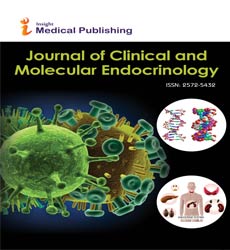Is Steroidogenesis Regulated by Er-Mitochondria Contact Sites?
Rousseau Denis
Rousseau Denis*
Laboratory for Fundamental and Applied Bioenergetics and SFR Environmental and Systems Biology, Joseph Fourier University, Grenoble, France
- *Corresponding Author:
- Denis R
Laboratory for Fundamental and Applied Bioenergetics and SFR Environmental and Systems Biology
Joseph Fourier University
Grenoble, France
Tel: 33- 04766356 00
Fax: 33- 0476514218
E-mail: Denis.Rousseau@ujf-grenoble.fr
Received date: November 11, 2016; Accepted date: November 17, 2016; Published date: November 20, 2016
Citation: Denis R (2016) Is Steroidogenesis Regulated by Er-Mitochondria Contact Sites?. J Clin Mol Endocrinol 1:35. doi: 10.21767/2572-5432.100033
Copyright: © 2016 Denis R. This is an open-access article distributed under the terms of the Creative Commons Attribution License, which permits unrestricted use, distribution, and reproduction in any medium, provided the original author and source are credited.
Letter to Editor
Steroids are main growth factors, hormones which synthesis in mammals occur in part through mitochondrial-related processes, rendering interesting the relation that could exist between mitochondrial activities (mainly respiration but also lipid synthesis and consumption) and steroids synthesis, particularly their anabolic effects.
From this essential nutriment which is cholesterol, essentially stored in the endoplasmic reticulum compartment of mammalian cells, the mitochondria will produce the essential precursor of steroids, pregnenolone, at a rate-limiting step. Therefore, among the enzymatic processes involved in the production of steroids, a master and controlled step happens in the mitochondria.
Steroids are numerous, and produced by different organs with specific functions. The corticoids are produced by adrenal cortex and corresponds to aldosterone, involved in hydric equilibrium, and cortisol, mainly involved in inflammation. Oestrogens and progesterone are produced by the ovary and the placenta, to control sexual cycle, pregnancy and lactation. Testosterone is the male “equivalent”, produced mainly by testis to promote growth. Out of these organs, only fibroblasts, neurons and glia are today know to produce steroids too.
Since all steroids productions imply a mitochondrial step, it is of big interest to understand how this occurs and how it can be modulated, regulated, as involved in pathologies.
One main question being asked today is to know how the cholesterol transits from ER to mitochondria, as this process is totally unknown. Recent advances in the field [1-3] have shown that the transport can occur through ER-Mitochondria contact sites [4] involving a newly discovered mitochondrial protein, ATAD3 (ATPase family AAA Domain-containing protein 3.
ATAD3 protein was discovered in 2005 as an oncogenic marker of tumours [5,6] and mainly studied at cancer level [7,8]. Inserted in the inner mitochondrial membrane [9,10], ATAD3 is also tethering the outer mitochondrial membrane as well as endoplasmic reticulum structures [11]. By the way, ATAD3 supports mitochondrial biogenesis [12,13]. As can be expected, ATAD3 is vital, as early as at the gastrula/implantation stage.
The recent findings in the field of ATAD3 came from endocrinologists studying progesterone synthesis [1,2]. They found both a molecular complex supporting cholesterol transfer in Leydig cells and that ATAD3 is essential for this function. The involvement of ATAD3 in cholesterol transport was confirmed by others [3].
Then, ATAD3 is the principal candidate protein to function as a link between inner/outer mitochondrial membranes and the endoplasmic reticulum, to support cholesterol transfer.
A focus on this protein might be of particular interest in order to better understand steroid-endocrine based pathologies.
References
- Rone MB, Midzak AS, Issop L, Rammouz G, Jagannathan S, (2016) Identification of a dynamic mitochondrial protein complex driving cholesterol import, trafficking, and metabolism to steroid hormones. Mol Endocrinol 26: 1868-1882.
- Issop L, Fan J, Lee S, Rone MB, Basu K, et al. (2015) Mitochondria-associated membrane formation in hormone-stimulated Leydig cell steroidogenesis: role of ATAD3. Endocrinology 156: 334-345.
- Gerhold JM, Cansiz-Arda S, Lõhmus M, Engberg O, Reyes A, (2015) Human Mitochondrial DNA-Protein Complexes Attach to a Cholesterol-Rich Membrane Structure. Sci Rep 19: 15292.
- Schlattner U, Tokarska-Schlattner M, Rousseau D, Boissan M, Mannella C (2015) Lacombe ML Mitochondrial cardiolipin/phospholipid trafficking: the role of membrane contact site complexes and lipid transfer proteins. Chem Phys Lipids 179: 32-41.
- Geuijen CA, Bijl N, Smit RC, Cox F, Throsby M, (2005) Visser TJ, Jongeneelen MA, Bakker AB, Kruisbeek AM, Goudsmit J, de Kruif J. A proteomic approach to tumour target identification using phage display, affinity purification and mass spectrometry. Eur J Cancer 41: 178-187.
- Schaffrik M, Mack B, Matthias C, Rauch J, Gires O (2006) Molecular characterization of the tumor-associated antigen AAA-TOB3. Cell Mol Life Sci 63: 2162-2174
- Hubstenberger A, Labourdette G, Baudier J, Rousseau D (2008) ATAD 3A and ATAD 3B are distal 1p-located genes differentially expressed in human glioma cell lines and present in vitro anti-oncogenic and chemoresistant properties. Exp Cell Res 314: 2870-2883.
- Li S, Rousseau D. (2012) ATAD, a vital membrane bound mitochondrial ATPase involved in tumor progression. J Bioenerg Biomembr 44: 189-197.
- Bogenhagen DF, Rousseau D, Burke S (2008) The layered structure of human mitochondrial DNA nucleoids. J Biol Chem 283: 3665-3675.
- Hubstenberger A, Merle N, Charton R, Brandolin G, Rousseau D (2010) Topological analysis of ATAD3A insertion in purified human mitochondria. J Bioenerg Biomembr 42: 143-150.
- Chiang SF, Huang CY, Lin TY, Chiou SH, Chow KC (2012) An alternative import pathway of AIF to the mitochondria. Int J Mol Med 29: 365-372.
- Li S, Yao Y, Xu R, Pesenti S, Cottet-Rousselle C, (2014) Rousseau D. ATAD3 is a limiting factor in mitochondrial biogenesis and adipogenesis of white adipocyte-like 3T3-L1 cells. Mol Cell Biol
- He J, Cooper HM, Reyes A, Di Re M, Sembongi H, et al. (2012) Mitochondrial nucleoid interacting proteins support mitochondrial protein synthesis. Nucleic Acids Res 40: 6109-6121
Open Access Journals
- Aquaculture & Veterinary Science
- Chemistry & Chemical Sciences
- Clinical Sciences
- Engineering
- General Science
- Genetics & Molecular Biology
- Health Care & Nursing
- Immunology & Microbiology
- Materials Science
- Mathematics & Physics
- Medical Sciences
- Neurology & Psychiatry
- Oncology & Cancer Science
- Pharmaceutical Sciences
